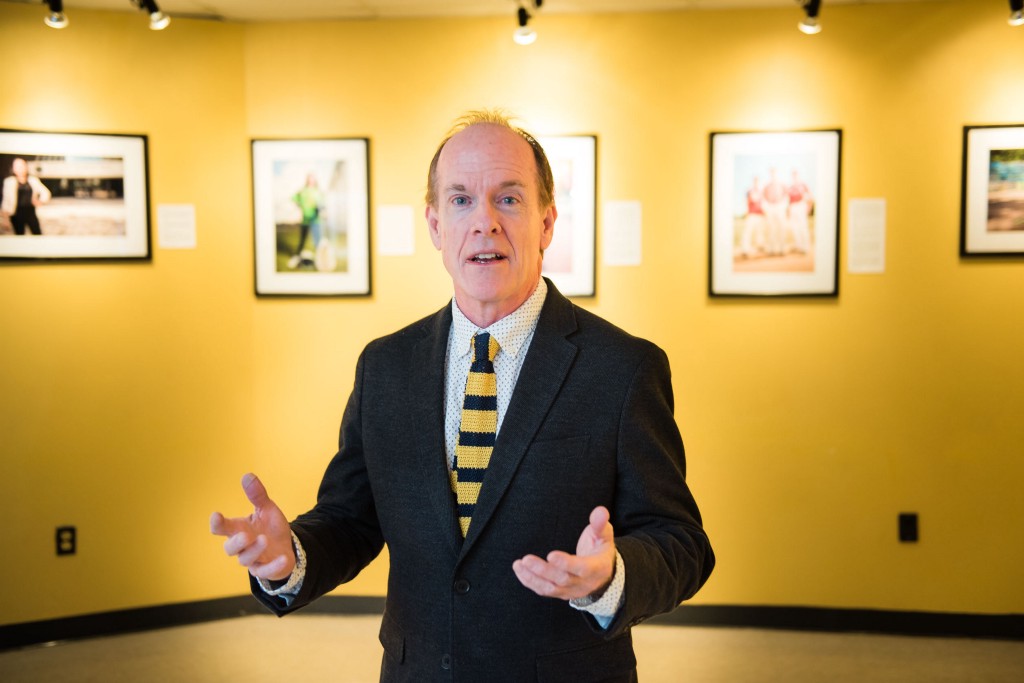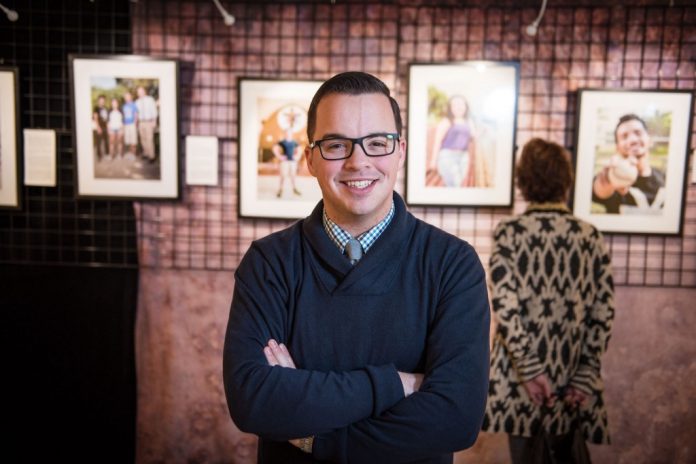Tim Gallagher (right), also a Northeast resident, founded the CASA mentoring program in 2012. MARIA S. YOUNG / TIMES PHOTO
Rolling Stone hit the teenagers from Camden like a brick to the face.
“Chaos is already here” and “literally dying” were two of the more repugnant portrayals of their hometown promulgated by the pop culture-centric periodical in its Dec. 19, 2013, issue, an edition that promoted Will Ferrell’s smirking Ron Burgundy and his wayward martini on the cover alongside a teaser for the hatchet job inside.
“Apocalypse New Jersey, America’s Most Desperate City,” stated the hyperbolic headline.
The article itself was even more inventive in its assessments.
“An un-Fantasy Island of extreme poverty and violence,” the text stated.
“Blocks full of Ninth Ward-style wreckage [that] gather waste and rats,” it continued, comparing the city to a quarter of New Orleans that was among the most-devastated by Hurricane Katrina.
The pure cynicism infuriated the teens involved in Camden Adolescents Striving for Achievement, a youth mentoring, service and spirituality program that had been founded one year earlier by 2006 Father Judge High School graduate Tim Gallagher in collaboration with Guadalupe Family Services.
“When I walked in here last fall, the kids were incensed by the article,” said Den Sweeney, a 1970 Judge grad and retired school teacher who helps out Gallagher. “They said, ‘We’re here every day, but nobody asked us what we’re doing.’ ”
That is, in researching for its article, Rolling Stone didn’t seek out any of the CASA kids. In the finished piece, the author quoted a multitude of brazen drug dealers, junkies, gangsters and killers. Local police had their say, too, generally echoing the adverse sentiments about the place.
But the narrative contained nothing about Camden folks like Javier Castro, a 17-year-old who overcame his largely solitary grade school years to blossom among his new peers in the CASA program and forge a path to college, where he plans to study graphic design.
Sweeney, a Mayfair resident who taught 34 years in Bensalem Township public schools, brought his expertise as a professional photographer and youth mentor to the program last November. With his guidance and their own inspiration, the CASA youths spent the ensuing year crafting their very personal response to the aspersions cast about Camden. It’s a biographical exhibition featuring portraits and essays about their experiences, challenges, accomplishments and dreams.
The project, called “Look Again: The Young People of CASA,” features 30 teenagers along with seven staff members and debuted in the Idea Center at Susquehanna Bank Center on Nov. 20 and 21. Starting in late May, it will be on view in the Stedman Gallery at Rutgers-Camden for five weeks.
On one hand, the participants hope that their work will raise public awareness of CASA and attract the kind of support it needs to grow beyond the cramped North Camden rowhouse where it now resides. But in a less tangible sense, they want their photos and stories to change how outsiders in the mass media and the public at-large view their proud city.
“My goal was to show that good things do come out of Camden,” said Rachelle Woodson, 16. “It’s not an all-bad place.”
Sweeney took most of the portraits, but Woodson selected another 16-year-old, Darwin Guzman, to photograph her. The image shows her standing in an empty lot, partially covered by hard dirt and pebbles, partially overgrown with weeds. Woodson poses in front of the Northgate Apartments, the government-subsidized high-rise apartment building where she’s “lived her whole life.”
She bows her head and gazes toward the ground, but her broad smile projects serenity.
“State troopers have repelled into the building from the roof … you can buy a different drug on every floor … people have been shot and murdered in this building … and I still rise!” Woodson wrote defiantly. “No matter what surrounds me, no matter who is trying to push me in the wrong direction, I am thriving.”
Like Guzman, Castro found his niche behind the camera. According to Sweeney, he’s already learned the basics as well as some advanced principles such as ambient lighting and off-camera flash. Castro photographed Kalanni Plaza, 16, in a local cemetery, sitting at the grave of her older brother Melvin, who died two years ago.
Castro has become like a new brother to Plaza.
“We were in CASA one day and discussing how to take her picture and we were like, ‘Let’s do something for your brother,’ ” Castro said. “It was an emotional day for both of us, a lot of tears.”
Jose Figueroa, 14, chose to pose on his bike in front of a lot where his former home once stood. He’s lived nine different places in his lifetime. Shortly after moving from the address shown in his photo, a gas explosion leveled the property.
“I thank God that none of my family was there and no one was hurt. It’s crazy how God works,” he later wrote. “At first I was upset about moving, but I’m glad that we did.”
Stephen Young took a different approach to his portrait, posing in a business suit along the Camden waterfront just before sunset, with the Philadelphia skyline framing his beaming countenance.
“I like the idea of a busy city going on behind me,” Young said. “It kind of gives recognition of where Camden is at.”
CASA endeavors to do the same through the city’s most valuable resource, its young people. The acronym is synonymous with the Spanish-language word for home, and the program provides kids with a second home during after-school hours.
The Rolling Stone article, despite its negativity, got at least a couple things right. Camden is incredibly young, with about 30 percent of the 77,000 residents under age 18. It’s also very poor, with about 42 percent of residents living below the poverty line as of two years ago.
After the murder total rose to 67 in 2012, an astounding number for a city with so few people, Gallagher turned to his employers at Guadalupe Family Services and proposed to combat the violence at its most basic levels — in the neighborhoods, one teenager at a time. Sister Helen Cole, S.S.J., the executive director of Guadalupe, was in full support.
“We’ve had a lot of programs over the last 20 years. And we have a lot of employees who are especially interested in working with teenagers. This was really our non-violence effort,” Cole said. “It was, ‘Join us instead of joining a gang.’ ”
Gallagher grew CASA from about 10 high school students in that first year to about 75 who are now involved. At first, they met one afternoon a week. Now they meet five times a week and have started a “next stop” group for students who have graduated high school and are now pursuing college degrees. About 25 take part in that.
The program targets academic success, life skills and mentoring, non-denominational Christian service and spiritual development. There are social trips (like a recent visit to the White House), speakers and workshops. Participants have helped out homeless people, needy veterans and animal shelters.
Many of the young people come from rough backgrounds, while others have very stable home lives. But inside CASA, they’re all treated the same.
“We measure our success on a one-by-one basis,” Gallagher said. “For some, that’s college. For others, it’s the military. Camden has a 64-percent high school graduation rate, but ours is 100 percent. And we have a 100-percent college retention rate.”
“When I came here, I saw eager kids who want to improve their lives and who want to use education to have better lives,” Sweeney said. ••

Dennis Sweeney (left), a Mayfair resident and retired school teacher, photographed students for the CASA exhibit. The project, called “Look Again: The Young People of CASA,” features 30 teenagers along with seven staff members. MARIA S. YOUNG / TIMES PHOTO

Capturing something great: Arlette Loyba (left) and Francene Matias (right) check out the Camden Adolescents Striving for Achievement (CASA) exhibit that features portraits and essays about positive youth experiences. CASA is a mentoring program founded by 2006 Father Judge graduate Tim Gallagher in collaboration with Guadalupe Family Services. MARIA S. YOUNG / TIMES PHOTO





